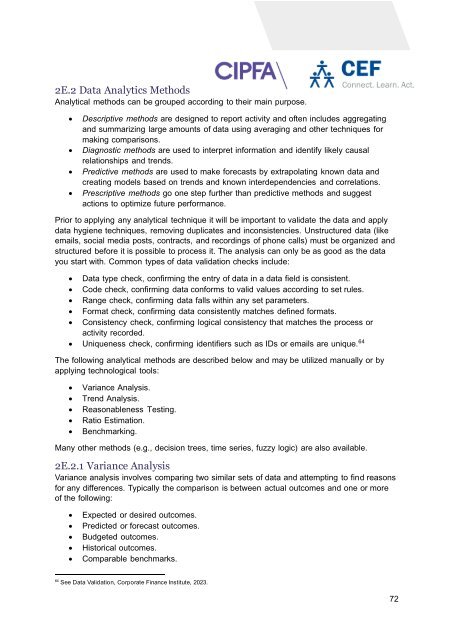TIAPS ALB_Module 2E. Data Analytics for Internal Auditing
- No tags were found...
You also want an ePaper? Increase the reach of your titles
YUMPU automatically turns print PDFs into web optimized ePapers that Google loves.
<strong>2E</strong>.2 <strong>Data</strong> <strong>Analytics</strong> Methods<br />
Analytical methods can be grouped according to their main purpose.<br />
• Descriptive methods are designed to report activity and often includes aggregating<br />
and summarizing large amounts of data using averaging and other techniques <strong>for</strong><br />
making comparisons.<br />
• Diagnostic methods are used to interpret in<strong>for</strong>mation and identify likely causal<br />
relationships and trends.<br />
• Predictive methods are used to make <strong>for</strong>ecasts by extrapolating known data and<br />
creating models based on trends and known interdependencies and correlations.<br />
• Prescriptive methods go one step further than predictive methods and suggest<br />
actions to optimize future per<strong>for</strong>mance.<br />
Prior to applying any analytical technique it will be important to validate the data and apply<br />
data hygiene techniques, removing duplicates and inconsistencies. Unstructured data (like<br />
emails, social media posts, contracts, and recordings of phone calls) must be organized and<br />
structured be<strong>for</strong>e it is possible to process it. The analysis can only be as good as the data<br />
you start with. Common types of data validation checks include:<br />
• <strong>Data</strong> type check, confirming the entry of data in a data field is consistent.<br />
• Code check, confirming data con<strong>for</strong>ms to valid values according to set rules.<br />
• Range check, confirming data falls within any set parameters.<br />
• Format check, confirming data consistently matches defined <strong>for</strong>mats.<br />
• Consistency check, confirming logical consistency that matches the process or<br />
activity recorded.<br />
• Uniqueness check, confirming identifiers such as IDs or emails are unique. 64<br />
The following analytical methods are described below and may be utilized manually or by<br />
applying technological tools:<br />
• Variance Analysis.<br />
• Trend Analysis.<br />
• Reasonableness Testing.<br />
• Ratio Estimation.<br />
• Benchmarking.<br />
Many other methods (e.g., decision trees, time series, fuzzy logic) are also available.<br />
<strong>2E</strong>.2.1 Variance Analysis<br />
Variance analysis involves comparing two similar sets of data and attempting to find reasons<br />
<strong>for</strong> any differences. Typically the comparison is between actual outcomes and one or more<br />
of the following:<br />
• Expected or desired outcomes.<br />
• Predicted or <strong>for</strong>ecast outcomes.<br />
• Budgeted outcomes.<br />
• Historical outcomes.<br />
• Comparable benchmarks.<br />
64<br />
See <strong>Data</strong> Validation, Corporate Finance Institute, 2023.<br />
72
















